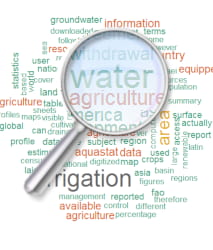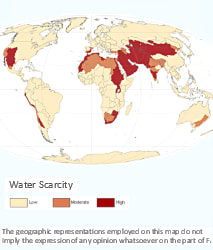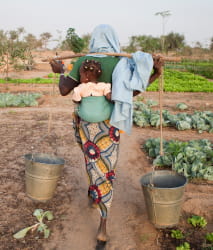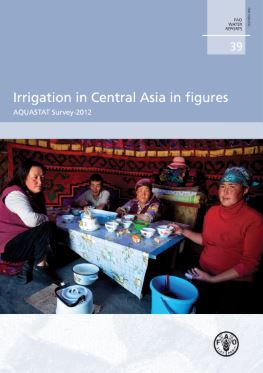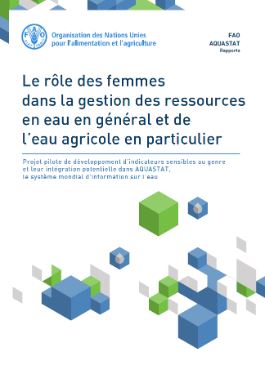AQUASTAT - FAO's Global Information System on Water and Agriculture

AQUASTAT is the FAO global information system on water resources and agricultural water management. It collects, analyses and provides free access to over 180 variables and indicators by country from 1960. AQUASTAT draws on national capacities and expertise with an emphasis on Africa, the Near East, countries of the former Soviet Union, Asia, and Latin America and the Caribbean. AQUASTAT plays a key role in the monitoring of the Sustainable Development Goal 6 that sets out to "ensure availability and sustainable management of water and sanitation for all", and in particular indicators of target 6.4 on water stress and water use efficiency.
Highlights
Get to know
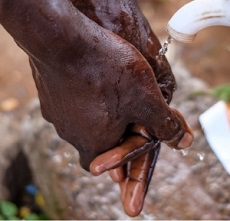
New AQUASTAT dissemination platform now online
The FAO Land and Water Division is pleased to announce the launch of the new AQUASTAT Dissemination Platform, FAO's global Information System on Water and Agriculture. The need for accurate, up-to-date information in water and agriculture is paramount for governments, international organizations, policy makers, researchers and all stakeholders involved in ensuring a sustainable water management in agriculture and the achievement of SDG 6 - Water for all. The new AQUASTAT dissemination system is designed to improve the access to the data and information related to water management and agriculture.
Key features of the new AQUASTAT Dissemination System include:
- Comprehensive data repository: The new platform hosts an extensive database of water and agricultural information with more than 180 variables and indicators by country from 1960, including SDG 6.4. target indicators on water-use efficiency and water stress.
- Improved speed and responsiveness: The new system has undergone significant optimizations, resulting in improved speed and responsiveness. Users can now access and retrieve data faster, enhancing their overall experience and productivity on the platform.
- User-friendly interface: We have developed an intuitive and user-friendly interface to ensure easy navigation and seamless access to the platform's features. Users can effortlessly explore different categories, search for specific topics, and find the information they need quickly.
- Advanced search functionality: The new system is equipped with a powerful search engine that allows users to filter and refine their search queries, enabling them to locate specific efficiently.
- Multiple ways of visualizing the data: including new preconfigured views, grid view and pivot view. Users can also customize how they want to visualize data.
- Data visualization on maps: The new platform offers a unique feature that allows users to visualize data on interactive maps. This visual representation enhances the understanding of geographical patterns, trends facilitating informed decision-making.
- Data download in Excel and CSV formats: Users have the flexibility to download data in Excel and CSV formats, enabling further analysis, integration with existing systems, and customization as per their specific needs.
- Multilingual platform in English, French and Spanish.
- Upcoming additions to enhance the platform includes aggregate data for specific regions.
To experience the new AQUASTAT platform first hand, we invite you to visit: https://data.apps.fao.org/aquastat. The platform includes a guided tour that will walk you through the various features and functionalities, ensuring you are well-equipped to utilize all the resources available.
Key publications
Irrigation in Central Asia in figures: AQUASTAT Survey - 2012
This report presents the results of the most recent survey carried out in the six countries of the Central Asia region, and it analyses the changes that have occurred in the ten years since the first survey. Section I describes in detail the methodology used and contains a glossary of the terms used. Section II contains the regional analysis presenting a synopsis on water resources, water use and irrigation in the region and the trends over the last ten years. It also describes the legislative and institutional framework for water management as well as environmental issues. Section III contains detailed country profiles for Afghanistan, Kazakhstan, Kyrgyzstan, Tajikistan, Turkmenistan and Uzbekistan, and one river basin profile for the Aral Sea basin.
The role of women in agricultural water management - Phase 2. Mainstreaming gender in data on agricultural water management
This paper presents the results of a follow-up project in Algeria and Tunisia on the development of gender-sensitive indicators related to the role of women in agricultural water management. The paper summarizes the results of the "Phase 1" project, then presents the results of two studies conducted in Algeria and Tunisia on institutional level actors dealing with agricultural water management and national-level sex-disaggregated data. Most importantly, the paper reflects on the efforts to mainstream gender in statistics relative to agricultural water management, the limitations in collecting this data and finally offers various recommendations to reduce the gaps related to gender in water statistics.
The State of the World’s Land and Water Resources for Food and Agriculture 2021 – Systems at breaking point
Satisfying the changing food habits and increased demand for food intensifies pressure on the world’s water, land and soil resources. However, agriculture bears great promise to alleviate these pressures and provide multiple opportunities to contribute to global goals. Sustainable agricultural practices lead to water saving, soil conservation, sustainable land management, conservation of natural resources, ecosystem and climate change benefits. Accomplishing this requires accurate information and a major change in how we manage these resources. It also requires complementing efforts from outside the natural resources management domain to maximize synergies and manage trade-offs
